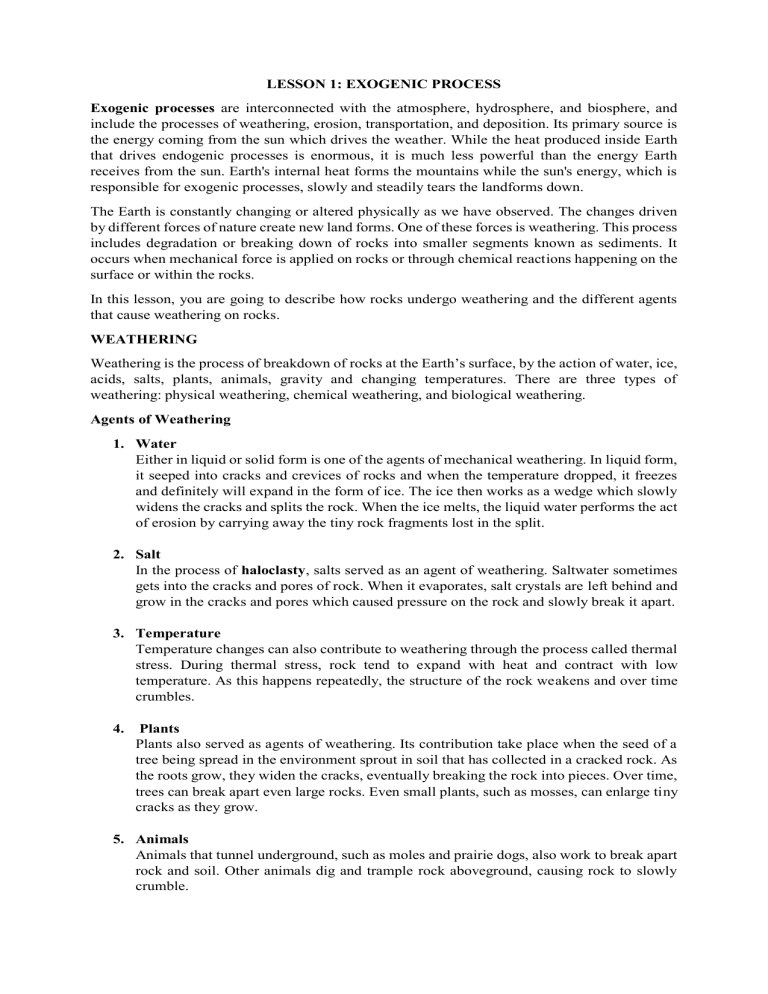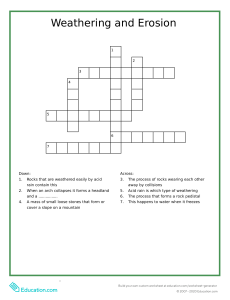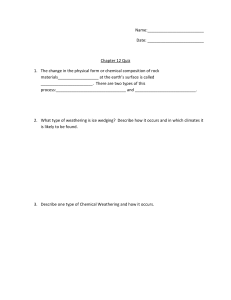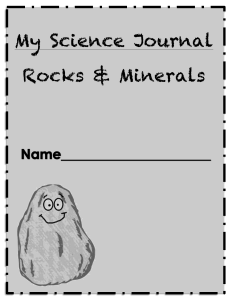
LESSON 1: EXOGENIC PROCESS Exogenic processes are interconnected with the atmosphere, hydrosphere, and biosphere, and include the processes of weathering, erosion, transportation, and deposition. Its primary source is the energy coming from the sun which drives the weather. While the heat produced inside Earth that drives endogenic processes is enormous, it is much less powerful than the energy Earth receives from the sun. Earth's internal heat forms the mountains while the sun's energy, which is responsible for exogenic processes, slowly and steadily tears the landforms down. The Earth is constantly changing or altered physically as we have observed. The changes driven by different forces of nature create new land forms. One of these forces is weathering. This process includes degradation or breaking down of rocks into smaller segments known as sediments. It occurs when mechanical force is applied on rocks or through chemical reactions happening on the surface or within the rocks. In this lesson, you are going to describe how rocks undergo weathering and the different agents that cause weathering on rocks. WEATHERING Weathering is the process of breakdown of rocks at the Earth’s surface, by the action of water, ice, acids, salts, plants, animals, gravity and changing temperatures. There are three types of weathering: physical weathering, chemical weathering, and biological weathering. Agents of Weathering 1. Water Either in liquid or solid form is one of the agents of mechanical weathering. In liquid form, it seeped into cracks and crevices of rocks and when the temperature dropped, it freezes and definitely will expand in the form of ice. The ice then works as a wedge which slowly widens the cracks and splits the rock. When the ice melts, the liquid water performs the act of erosion by carrying away the tiny rock fragments lost in the split. 2. Salt In the process of haloclasty, salts served as an agent of weathering. Saltwater sometimes gets into the cracks and pores of rock. When it evaporates, salt crystals are left behind and grow in the cracks and pores which caused pressure on the rock and slowly break it apart. 3. Temperature Temperature changes can also contribute to weathering through the process called thermal stress. During thermal stress, rock tend to expand with heat and contract with low temperature. As this happens repeatedly, the structure of the rock weakens and over time crumbles. 4. Plants Plants also served as agents of weathering. Its contribution take place when the seed of a tree being spread in the environment sprout in soil that has collected in a cracked rock. As the roots grow, they widen the cracks, eventually breaking the rock into pieces. Over time, trees can break apart even large rocks. Even small plants, such as mosses, can enlarge tiny cracks as they grow. 5. Animals Animals that tunnel underground, such as moles and prairie dogs, also work to break apart rock and soil. Other animals dig and trample rock aboveground, causing rock to slowly crumble. Types of Weathering A. Physical Weathering Physical weathering is caused by the effects of changing temperatures on rocks, causing the rock to break apart. The process is sometimes assisted by water. It happens especially in places where there is little soil and few plants grow, such as in mountain regions and hot deserts. It occurs either through repeated melting and freezing of water (mountains and tundra) or through expansion and contraction of the surface layer of rocks that are baked by the sun (hot deserts). There are two main types of physical weathering: 1. Abrasion. It occurs when rocks surface is frequently exposed to water, wind and gravity. 2. Freeze-thaw. It occurs when water continually seeps into cracks, freezes and expands, eventually breaking the rock apart. It occurs in mountainous regions like the Alps or Snowdonia. It occurs through the following process: Rainwater or snow- melt collects in cracks in the rocks→ at night the temperature drops and the water freezes and expands→ the increases in volume of the ice exerts pressure on the cracks in the rock, causing them to split further open→ during the day the ice melts and the water seeps deeper into the cracks → at night, the water freezes again. 3. Exfoliation. It can happen as cracks develop parallel to the land surface as a consequence of the reduction in pressure during uplift and erosion. It occurs typically in upland areas where there are exposures of uniform coarsely crystalline igneous rocks. The following are the process of exfoliation. The rock mass at depth is under high pressure from underlying rocks. It tends to be uniform and lack fractures. → As progressive erosion occurs, the rock mass is subjected to progressively lower pressure of overlying rocks which leads to tension in directions at right angles to the land surface → this tension is relieved by formation of cracks which follow the land surface. They are relatively flat on plateaus but can be steep on the flanks of mountains which are called exfoliation domes → once the crack is developed; water enters and causes chemical weathering leading to the formation of new low- density minerals. This enhances the cracks and encourages slabs of rock to detach from the surface. B. Chemical Weathering Chemical weathering is caused by rainwater reacting with the mineral grains in rocks to form new minerals (clays) and soluble salts. These reactions occur particularly when the water is slightly acidic. These chemical processes need water, and occur more rapidly at higher temperature, so warm, damp climates are best. Chemical weathering (especially hydrolysis and oxidation) is the first stage in the production of soils. There are different types of chemical weathering, the most important are: 1. Carbonation – carbon dioxide in the air dissolves in rainwater and becomes weakly acidic. This weak “carbonic acid” can dissolve limestone as it seeps into cracks and cavities. Over many years, solution of the rock can form spectacular cave systems. 2. Hydrolysis – the breakdown of rock by acidic water to produce clay and soluble salts. Hydrolysis takes place when acid rain reacts with rock-forming minerals such as feldspar to produce clay and salts that are removed in solution. The only common rockforming mineral that is not affected is quartz, which is a chemically resistant mineral. Therefore, quartz and clay are the two of the most common minerals in sedimentary rocks. 3. Hydration – a type of chemical weathering where water reacts chemically with the rocks, modifying its chemical structure. Example: H2O (water) is added to CaSO4 (calcium sulfate) to create CaSO4 + 2H2O (calcium sulfate dihydrate). It changes from anhydrite to gypsum. 4. Oxidation – the breakdown of rock by oxygen and water, often giving iron- rich rocks a rusty-colored weathered surface. C. Biological Weathering Biological weathering of rocks occurs when rocks are weakened by different biological agents like plants and animals. When plant roots grow through rocks, it creates fracture and cracks that result eventually to rock breakage. It can be classified into: 1. Biological Weathering by Physical Means. Burrowing animals like shrews, moles and earthworms create holes on the ground by excavation and move the rock fragments to the surface. These fragments become more exposed to other environmental factors that can further enhance their weathering. Furthermore, humans also indirectly contribute to biological weathering by different activities that cause rocks to break. 2. Biological Weathering by Chemical Compounds. Some plants and animals also produced acidic substances that react with the rock and cause its slow disintegration. Most of the time, physical and chemical weathering occur simultaneously in disintegrating the rocks to form sediments. However, rock types do not weather at the same rate when exposed to the surface. Soft rocks like shale weather faster than hard rocks like sandstone. This creates indentations in rock slopes composed of alternating soft and hard rock layers. Weathering is an important process in the formation of soil. The products of weathering, along with organic matter, form the soils that host the primary producers that sustain life on Earth. Resources: Earth Science for STEM Quarter 2 – Module 1: Weathering Cited at: https://depedtambayan.net/wpcontent/uploads/2021/11/earthscienceforstem_q2_mod1_weathering_v2.pdf Olivar II, JS et. al (2018). Exploring Life through Sciences Series: Earth Science





